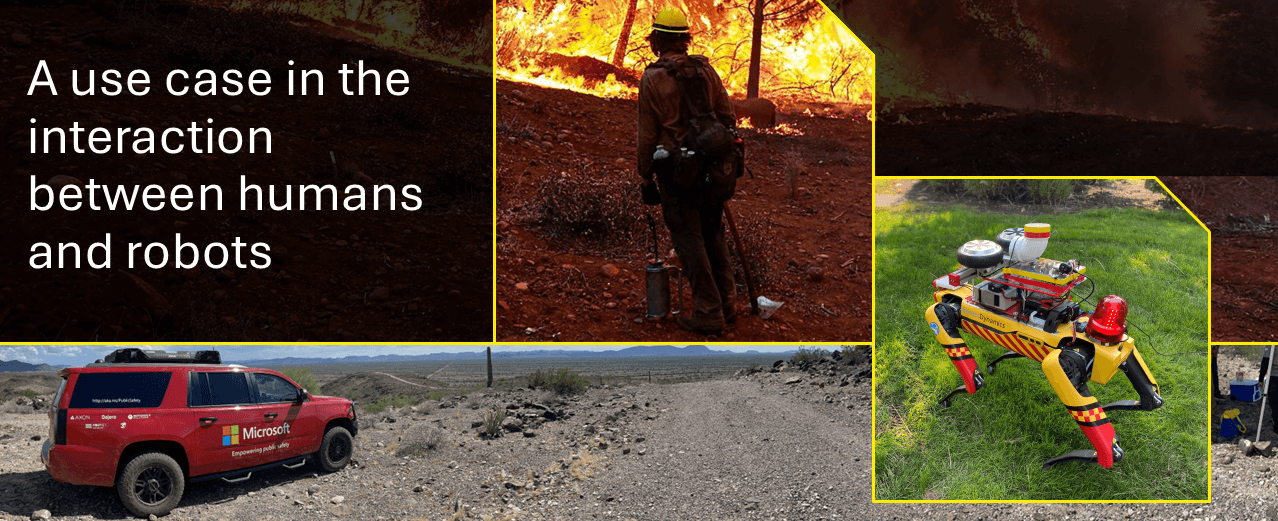Robotics for Wildfire Protection and Mitigation
A use case in the interaction between humans and robots

A core pillar of the strategy we're building is about how humans, robots and AI agents team together. This project was a catalyst for that.
About Robotics for Wildfire Protection and Mitigation
The summer of 2022 in the United States was marked by relentless wildfires, which scorched millions of acres and devastated communities. According to the National Interagency Fire Center, 66,255 fires burned a staggering 7,534,403 acres. The wildfire season had lengthened due to warmer springs, extended summer dry periods, and increasingly arid soils. Amid this chaos, a team of passionate innovators working with The Garage developed a groundbreaking solution: Robotics for Wildfire Protection and Mitigation.
The idea was sparked during Microsoft Global Hackathon 2022, as the Mosquito Fire raged in California, devastating 76,788 acres and lasting nearly two months. Wildfires have continued to impact countless lives and have caused tragic losses among firefighters. During this time, Lou Amadio, a Principal Architect living in Washington state, felt a personal urgency. “My home is in a wildfire-prone area. Every year we watch helplessly as fires spring up and are valiantly fought by firefighters across the state,” says Lou, who proposed the Wildfire Robotics Hackathon plan. “Could robots help with early detection, or keep firefighters safe while fighting wildfires?” Inspired by the urgent need for advanced wildfire protection, the project team embarked on this ambitious initiative.
That decision set a series of dominoes in motion, ultimately branching into two outcomes: one that explored human-robot interaction, and another that advanced an understanding of the state of wildfire protection and mitigation in unanticipated ways.
Through relentless iterations and pivots, the team achieved remarkable technical breakthroughs. “We wanted to test several hypotheses around robots helping fight fires by keeping firefighters at a safe distance from flames and potentially harmful chemicals,” explained Dan Rosenstein, Principal Group Program Manager.
Carrying water posed an obvious challenge for robotics, so the team drew inspiration from “fire extinguisher balls”—pyrotechnic devices that disperse a dry chemical suppressant called monoammonium phosphate. This compound not only extinguishes fires but acts as a fertilizer to aid forest recovery.
Building on that, the team explored how to integrate robots into command-and-control software, which is increasingly used to coordinate wildfire response. “TAK, the Team Awareness Kit software introduced by the U.S. government and contractors, is being widely adopted by disaster response agencies. We developed a software adapter that allows the robots to report their positions and receive path plans from team leaders,” said Lou.
The project has highlighted opportunities for significant enhancements to wildfire protection efforts. During the Hackathon, the team connected with Microsoft’s emergency response personnel, who support first responders around the world. They learned that the “mop-up” phase—occurring shortly after flames are extinguished—poses serious risks to firefighters due to the high potential for flare-ups. Robots can be especially valuable during this phase. Many brave firefighters have lost their lives to such flare-ups. “If we can deploy robots and drones to scan for ‘hot spots,’ they can share geolocated markers for air drops or suppression from afar. We faced numerous challenges, but our determination and collaborative spirit kept us going,” emphasized Dan.
The Microsoft Garage provided an environment where creativity and innovation thrived. Dan beamed, “The Hackathon is for all of us. There’s learning, there’s a business challenge, there’s opportunity, there’s a chance to brush up on coding skills, and this germinates the desire to do Hackathon again.” Ed Essey, the head coach from The Garage who helped the team advance their project, shared, “This is an important project that is helping save lives. It also uncovers how early-stage innovation can reveal unexpected opportunities.”
Some of those unexpected opportunities were like dominoes the team hadn’t even seen at the start. As the first idea tipped forward, it set off two distinct trails—one that illuminated systemic challenges in wildfire response, and another that opened new possibilities for human-robot collaboration.
The first trail of dominoes revealed foundational opportunities in wildland firefighting. Before robotics can be truly effective, the ecosystem must undergo a digital transformation—from printed maps to digital tools. This realization sparked modernization efforts, laying the groundwork for more efficient operations and future technology integration. It also exposed critical barriers: limited budgets and the need for phased adoption of new technologies. With funding scarce, robotics remain out of reach for many, prompting a pivot toward cost-effective solutions and advocacy for increased investment. Meanwhile, traditional practices are still widespread, making training and education essential to build trust in digital tools and pave the way for broader adoption.
That realization triggered a second trail of dominoes—this time leading toward advanced human-robot collaboration. While some use cases remain confidential, several milestones have already been made public. The Hackathon led to the development of a Teams-based interface for human-robot-AI interaction, enabling remote control of robots during a call. This breakthrough demonstrated the potential to expand to human-robot-AI teaming and align with Microsoft’s broader strategic vision. The work sparked new initiatives, influenced company direction, and generated a wave of innovation—cementing the project’s impact on business value.
Today, the project continues to evolve within Microsoft, advancing with new goals and initiatives, and in making positive change in wildfire protection and mitigation.
This innovative project exemplifies The Garage’s emphasis on fostering creativity and problem-solving toward meaningful impact.
Team
Lou Amadio, Dan Rosenstein, Mark Stevens, Ankit Sandel, Bandhan Dutta, Benjamin Huang, Carsten Avenhaus, Chi Shing Tsui, Cigdem Cimen Aygun, Deniz Ercoskun, Eduardo Castillo Perera, Felipe Vieira Frujeri, Franco Villella Romero, Geetika Singla, Gina Triolo, Gunter Logemann, Julien Côté, Justin Diekhans, Karthick PS, Lewis Curtis, Manoharan Thambi, Muthu Arivoli, Patrick Wong, Pranav Dhulipala, Ryan Bates, Ryan Ramkalawan, Samuel Van Nes, Stavan Dholakia, Tolli Forker, Zafri Yusoff
